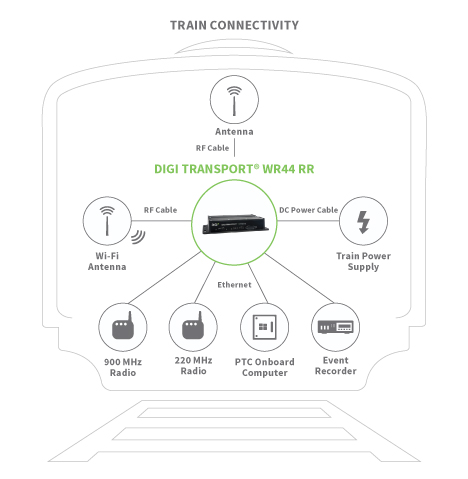98ed.jpg?lang=en-us&width=640&height=313&ext=.jpg)
Serving more than one million riders each day, the Southeastern Pennsylvania Transportation Authority (SEPTA) is the nation’s sixth-largest public transportation system, providing bus, subway, light rail, regional rail and paratransit services across five counties in and around Philadelphia. SEPTA provides over 300 million trips annually on a rail network comprising over 450 miles of track.
Business Challenge
Each day, when customers choose to use SEPTA’s acclaimed – and growing – rail service, the goal is to ensure they enjoy the most pleasant travel experience possible. But first and foremost, SEPTA is committed to providing a safe riding experience and environment. In recent years, tragic accidents around our nation have called attention to the need to ensure that safety remains one of fundamental principles of the transit industry. SEPTA has committed to establish a safety-first culture for riders and employees alike.
One of the key initiatives to achieving this goal has been compliance with the U.S. Congressional mandate for Positive Train Control (PTC), a sophisticated train-signaling system designed to prevent crashes, derailments and track worker injuries resulting from speed and signal violations. In a PTC environment, connected equipment monitors and controls train movements and speeds, preventing the train from moving unless on-board computer equipment receives a positive indication (from a centralized dispatching authority) that it is safe to travel. PTC improves the safety of railway traffic in several ways:
- Regulating train separation
- Avoiding train-to-train collisions at track crossovers
- Enforcing line speed restrictions, including temporary speed restrictions
- Protecting rail worker wayside safety zones
- Regulating grade crossings that are out of service
- Preventing trains from running over a mainline switch set in the wrong position
Solution
SEPTA is one of just a few customer rail systems in the United States to achieve PTC compliance in revenue services. One of the keys to SEPTA’s PTC compliance is its deployment of the Digi® WR44-RR mobile access router. SEPTA PTC message routing and wireless communications use the Mobile Communications Package (MCP), an integrated drop-in assembly that houses the Digi WR44 RR, 220 MHz TDMA radio, power supply and RF filters. The Digi WR44 RR is the integral communications hub in all locomotives and vehicles, relaying PTC data messages to and from waysides via 220 MHz radio and enabling remote system maintenance, configuration and network management over a cellular link. The Digi WR44 RR router is purpose-built for the rail industry and designed to be mounted on-board locomotives and other rail vehicles. It meets all rail-certification requirements for AREMA C and H, EN50155, and AAR S-5702. This cellular, enterprise-class router is equipped with M12 connectors, integrated four-port Ethernet switch, high speed Wi-Fi, serial and a 50-channel GPS receiver.
The Digi WR44 RR router is purpose-built for the rail industry and designed to be mounted on-board locomotives and other rail vehicles. It meets all rail-certification requirements for AREMA C and H, EN50155, and AAR S-5702. This cellular, enterprise-class router is equipped with M12 connectors, integrated four-port Ethernet switch, high speed Wi-Fi, serial and a 50-channel GPS receiver.
The Digi router is equipped with advanced routing, security and firewall features including stateful firewall inspection and integrated VPN. Edge computing using the WR44 RR's embedded python environment enables quick adaptation to future evolving system requirements. Enterprise-class protocols incorporate BGP, OSPF and VRRP+, a patented technology built upon the popular VRRP failover standard providing true auto-sensing, auto-failure and auto-recovery of any line drop. Secure remote access to on-board systems is monitored using SNMPv3 and/or Digi Remote Manager®, a web-based management tool that monitors both device and network health in mobile locations, and sends automated updates to minimize service disruptions.
Results
In metropolitan areas, the reliability of cellular networks now rivals traditional wired networks. Well-designed PTC deployments that leverage the Digi WR44 router can achieve very high availability. A fault tolerant failsafe communication network is achieved when used in combination with dedicated trackside fiber and 220 MHz radios.
In 2016 SEPTA became the first commuter railroad east of the Mississippi, and the second in the nation, to implement PTC. All 13 of SEPTA Regional Rail Lines, including those that operate on Amtrak-owned track (in 2017), now operate under PTC. What’s more, SEPTA is working with freight railroads that operate on portions of SEPTA-owned track to ensure they also meet the PTC mandate.
The increased network reliability and rail system visibility extends the performance beyond PTC, toward Communications-Based Train Control (CBTC), which leads to more efficient scheduling, increased capacity and fuel savings. So while rail safety is the principal objective, there are significant ancillary benefits.